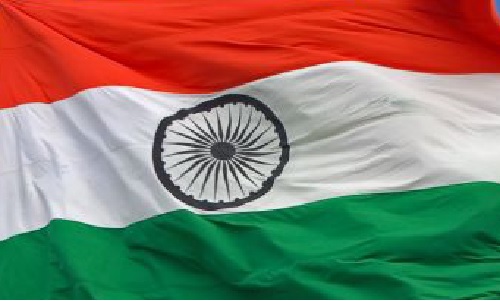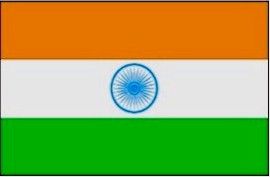National Flag Of India | Indian Tricolor | Tiranga

The Indian National Flag or National Flag of India is a horizontal tricolor (Tiranga) of deep saffron (#FF9933) at the top, white (#FFFFFF) in the middle, and dark green (#138808) at the bottom in equal proportion. The ratio of the width of the flag to its length is two to three (2:3). In the center of the white band is a navy-blue wheel that represents the chakra (Ashoka Chakra). Its design is that of the wheel of the Sarnath Lion Capital of Ashoka. Its diameter approximates the width of the white band and it has 24 spokes.
National Flag :
On 15 August 1947 India and Pakistan were created. India adopted the tricolor of orange, white, and green with a blue Ashoka Chakra at the center. Unofficially this tricolor had been the flag of the Indian National Congress. The orange color represented Hinduism, the green color – Islam, and the white color represented peace. There was a blue spinning wheel in the center that represented Gandhi Ji’s call for economic self-sufficiency through hand-spinning.
Suggested Read: National Symbols Of India
Flag Adoption :
The design of the national flag was adopted by the Constituent Assembly of India on 22 July 1947.
Colors of the Flag :

In the national flag of India, the top band is of Saffron color, indicating the strength and courage of the country. The white middle band indicates peace and truth with Dharma Chakra. The last band is green in color shows the fertility, growth, and auspiciousness of the land.
The Chakra :
The spoked Ashoka Chakra in the center of the flag replaced the Gandhian spinning wheel to add historical “depth” and separate the national flag from that of the Indian National Congress. This Dharma Chakra depicted the “wheel of the law” in the Sarnath Lion Capital made by the 3rd-century BC Mauryan Emperor Ashoka. The chakra intends to show that there is life in movement and death in stagnation.
The preamble to the Flag Code of India :
The following is an extract from the preamble to the flag code of India as posted on the official Home Ministry website of the Indian government:
“The significance of the colors and the chakra in the National Flag was amply described by Dr. S. Radhakrishnan in the Constituent Assembly which unanimously adopted the National Flag. Dr. S. Radhakrishnan explained – “Bhagwa or the saffron color denotes renunciation of disinterestedness. Our leaders must be indifferent to material gains and dedicate themselves to their work.” “The white in the center is light, the path of truth to guide our conduct.” “The green shows our relation to soil, our relation to the plant life here on which all other life depends.”
“The Ashoka Wheel in the center of the white is the wheel of the law of dharma. Truth or Satya, dharma, or virtue ought to be the controlling principles of those who work under this flag. Again, the wheel denotes motion. There is death in stagnation. There is life in movement. India should no more resist change, it must move and go forward. The wheel represents the dynamism of a peaceful change.”
Suggested Read: National Anthem Of India
Flag Code :
On 26th January 2002, the flag code was changed. After 52 years, the citizens of India are free to fly the Indian flag over their homes, offices, and factories on any day. Now Indians can proudly display the national flag anywhere and any time.
There are some rules and regulations on how to fly the flag, based on the 26 January 2002 legislation. These include the following:
The Do:
-
The National Flag may be hoisted in educational institutions (schools, colleges, sports camps, scout camps, etc.) to inspire respect for the Flag. An oath of allegiance has been included in the flag hoisting in schools.
-
A member of the public, a private organization, or an educational institution may hoist/display the National Flag on all days and occasions, ceremonial or otherwise consistent with the dignity and honor of the National Flag.
-
Section 2 of the new code accepts the right of all private citizens to fly the flag on their premises.
The Don’ts :
-
The flag cannot be used for communal gains, drapery, or clothes. As far as possible, it should be flown from sunrise to sunset, irrespective of the weather.
-
The flag cannot be intentionally allowed to touch the ground or the floor or trail in the water. It cannot be draped over the hood, top, and sides or back of vehicles, trains,
boats or aircraft. -
No other flag or bunting can be placed higher than the flag. Also, no object, including flowers or garlands, or emblems can be placed on or above the flag. The tricolor cannot be used as a festoon, rosette, or bunting.
Suggested Read: National Emblem Of India






